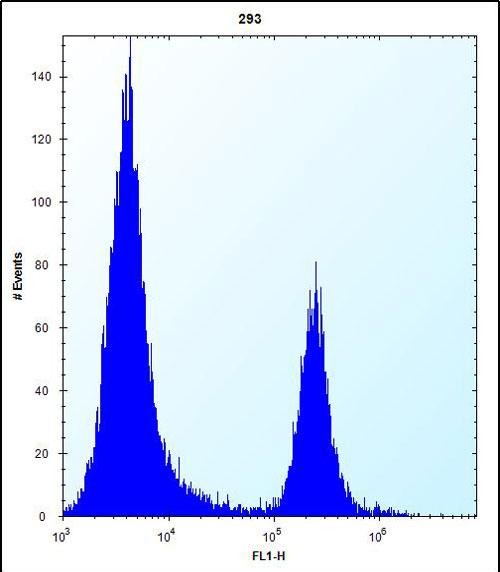CBR3 Antibody (C-term)
Purified Rabbit Polyclonal Antibody (Pab)
- SPECIFICATION
- CITATIONS
- PROTOCOLS
- BACKGROUND

Application
| FC, WB, E |
|---|---|
| Primary Accession | O75828 |
| Other Accession | NP_001227.1 |
| Reactivity | Human |
| Host | Rabbit |
| Clonality | Polyclonal |
| Isotype | Rabbit IgG |
| Calculated MW | 30850 Da |
| Antigen Region | 195-224 aa |
| Gene ID | 874 |
|---|---|
| Other Names | Carbonyl reductase [NADPH] 3, NADPH-dependent carbonyl reductase 3, CBR3 |
| Target/Specificity | This CBR3 antibody is generated from rabbits immunized with a KLH conjugated synthetic peptide between 195-224 amino acids from the C-terminal region of human CBR3. |
| Dilution | FC~~1:10~50 WB~~1:1000 E~~Use at an assay dependent concentration. |
| Format | Purified polyclonal antibody supplied in PBS with 0.09% (W/V) sodium azide. This antibody is prepared by Saturated Ammonium Sulfate (SAS) precipitation followed by dialysis against PBS. |
| Storage | Maintain refrigerated at 2-8°C for up to 2 weeks. For long term storage store at -20°C in small aliquots to prevent freeze-thaw cycles. |
| Precautions | CBR3 Antibody (C-term) is for research use only and not for use in diagnostic or therapeutic procedures. |
| Name | CBR3 (HGNC:1549) |
|---|---|
| Function | Catalyzes the NADPH-dependent reduction of carbonyl compounds to their corresponding alcohols (PubMed:18493841). Has low NADPH- dependent oxidoreductase activity. Acts on several orthoquinones, acts as well on non-quinone compounds, such as isatin or on the anticancer drug oracin (PubMed:15537833, PubMed:18493841, PubMed:19841672). Best substrates for CBR3 is 1,2- naphthoquinone, hence could play a role in protection against cytotoxicity of exogenous quinones (PubMed:19841672). Exerts activity toward ortho-quinones but not paraquinones. No endogenous substrate for CBR3 except isatin has been identified (PubMed:19841672). |
| Cellular Location | Cytoplasm. |
| Tissue Location | Detected in ovary, pancreas, intestine, colon, kidney, brain, thymus, lung, heart, liver, spleen, leukocyte, prostate and testis. |

Thousands of laboratories across the world have published research that depended on the performance of antibodies from Abcepta to advance their research. Check out links to articles that cite our products in major peer-reviewed journals, organized by research category.
info@abcepta.com, and receive a free "I Love Antibodies" mug.
Provided below are standard protocols that you may find useful for product applications.
Background
Carbonyl reductase 3 catalyzes the reduction of a large number of biologically and pharmacologically active carbonyl compounds to their corresponding alcohols. The enzyme is classified as a monomeric NADPH-dependent oxidoreductase. CBR3 contains three exons spanning 11.2 kilobases and is closely linked to another carbonyl reductase gene - CBR1.
References
Guey, L.T., et al. Eur. Urol. 57(2):283-292(2010)
Hosgood, H.D. III, et al. Respir Med 103(12):1866-1870(2009)
Zhang, J., et al. Pharm. Res. 26(9):2209-2215(2009)
Choi, J.Y., et al. Clin. Cancer Res. 15(16):5258-5266(2009)
Pilka, E.S., et al. PLoS ONE 4 (10), E7113 (2009) :
If you have used an Abcepta product and would like to share how it has performed, please click on the "Submit Review" button and provide the requested information. Our staff will examine and post your review and contact you if needed.
If you have any additional inquiries please email technical services at tech@abcepta.com.













 Foundational characteristics of cancer include proliferation, angiogenesis, migration, evasion of apoptosis, and cellular immortality. Find key markers for these cellular processes and antibodies to detect them.
Foundational characteristics of cancer include proliferation, angiogenesis, migration, evasion of apoptosis, and cellular immortality. Find key markers for these cellular processes and antibodies to detect them. The SUMOplot™ Analysis Program predicts and scores sumoylation sites in your protein. SUMOylation is a post-translational modification involved in various cellular processes, such as nuclear-cytosolic transport, transcriptional regulation, apoptosis, protein stability, response to stress, and progression through the cell cycle.
The SUMOplot™ Analysis Program predicts and scores sumoylation sites in your protein. SUMOylation is a post-translational modification involved in various cellular processes, such as nuclear-cytosolic transport, transcriptional regulation, apoptosis, protein stability, response to stress, and progression through the cell cycle. The Autophagy Receptor Motif Plotter predicts and scores autophagy receptor binding sites in your protein. Identifying proteins connected to this pathway is critical to understanding the role of autophagy in physiological as well as pathological processes such as development, differentiation, neurodegenerative diseases, stress, infection, and cancer.
The Autophagy Receptor Motif Plotter predicts and scores autophagy receptor binding sites in your protein. Identifying proteins connected to this pathway is critical to understanding the role of autophagy in physiological as well as pathological processes such as development, differentiation, neurodegenerative diseases, stress, infection, and cancer.



